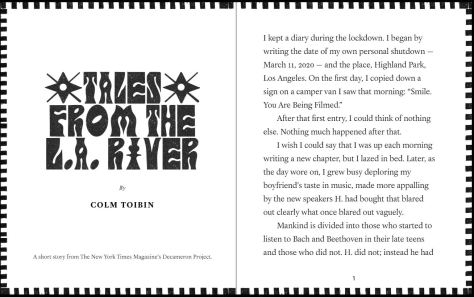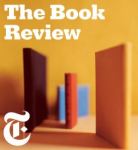 Daniel Mendelsohn discusses Mitchell’s career and new novel, “Utopia Avenue,” and Maria Konnikova talks about “The Biggest Bluff.”
Daniel Mendelsohn discusses Mitchell’s career and new novel, “Utopia Avenue,” and Maria Konnikova talks about “The Biggest Bluff.”
Tag Archives: NY Times
Best New Fiction 2020: “The Decameron Project – The New York Times Magazine”
AS THE COVID-19 PANDEMIC SWEPT THE WORLD, WE ASKED 29 AUTHORS TO WRITE NEW SHORT STORIES INSPIRED BY THE MOMENT. WE WERE INSPIRED BY GIOVANNI BOCCACCIO’S “THE DECAMERON,” WRITTEN AS THE PLAGUE RAVAGED FLORENCE IN THE 14TH CENTURY. 


Interviews: Richard Haass – “The World – A Brief Introduction” (Podcast)
 “The whole lesson of this pandemic, and the whole lesson of 9/11, is we can’t ignore the world, or if we do ignore the world, it’s at our peril,” Haass says. “These oceans that surround us are not moats. We’ve got to pay attention to the world and we’ve got to fix things here at home.”
“The whole lesson of this pandemic, and the whole lesson of 9/11, is we can’t ignore the world, or if we do ignore the world, it’s at our peril,” Haass says. “These oceans that surround us are not moats. We’ve got to pay attention to the world and we’ve got to fix things here at home.”
The ambition of Richard Haass’s new book is clear from its title: “The World: A Brief Introduction.” In just 400 pages, Haass, who has been the president of the nonpartisan Council on Foreign Relations since 2003, offers a primer on world affairs. On this week’s podcast, Haass talks about why he wrote it. (Read more)
Richard Nathan Haass is an American diplomat. He has been president of the Council on Foreign Relations since July 2003, prior to which he was Director of Policy Planning for the United States Department of State and a close advisor to Secretary of State Colin Powell.
Interviews: Travel Guru “Rick Steves” (NYT Podcast)
 Rick Steves is a travel evangelist, always in motion, traversing faraway places and inspiring others to do the same. So when the world shuts down, and Rick Steves can no longer travel, then who is Rick Steves?
Rick Steves is a travel evangelist, always in motion, traversing faraway places and inspiring others to do the same. So when the world shuts down, and Rick Steves can no longer travel, then who is Rick Steves?
Sam Anderson, a writer for The Times Magazine, profiled the travel guru last year. Today, Sam asks Rick how he’s been expanding his horizons from home. Dreaming of travel, we learn, is nearly as sweet as the real thing.

Reopening The Economy: “What The Year Ahead Might Look Like” (NY Times)
 Donald G. McNeil Jr., a science and health reporter for The New York Times, discusses how the Coronavirus lockdown might end what it would look like.
Donald G. McNeil Jr., a science and health reporter for The New York Times, discusses how the Coronavirus lockdown might end what it would look like.
While the economy is likely to reopen slowly, there is hope that society will adapt to manage the uncertainty of our new circumstances. Here’s what experts say the next year (or more) will look like.
New Virtual Travel Tour: “Zambia And Beyond” With Photographer Marcus Westberg (NY Times Video)
Does wanderlust have you wistfully gazing out the window? Yeah, us too. Hit the virtual road with Times journalists and photographers, as they share never-before-seen video, photos and experiences from captivating spots around the globe, every Saturday. This week, we’re going on safari in search of Zambia’s stunning wildlife.
With special guest Marcus Westberg, photographer. Hosted by Amy Virshup, travel editor.
Future Of Travel: Google Maps Offers The World (At 100% Discount Pricing)
From a New York Times article (March 24, 2020):
What I find particularly seductive about Google Street View is that it purports to be a very objective document of our world. It is simply the product of a car (or a motorbike or a hiker) driving down a street taking pictures. But, of course, it is far from an objective document. Humans get in the way, as they always do, filling each scene with stories.

There is something tantalizing about being there but not being there, about being everywhere and nowhere at once. The geospatial distance leaves us wanting, hungry for more. I’m enamored with the glitchiness of these human landscapes, the way people’s legs are sometimes separated from their bodies, the way everyone’s faces are blurred out, as if they no longer exist (sometimes they no longer do). This is our world, but it is not our world.
Video Profiles: “Remote, Subarctic Backdrops” Of Nova Scotia Architect Omar Gandhi (NY Times)

Though Gandhi’s projects are dramatically different in form, such consideration of their remote, subarctic backdrop connects them to one another — they “look like they could only be in Nova Scotia,” he says.
EVERY FEW DAYS, the Canadian architect Omar Gandhi migrates between Toronto, his hometown, and Halifax, the capital of Nova Scotia, where he opened his eponymous firm in 2010. A year and a half ago, Gandhi added New Haven to his weekly peregrinations — he was teaching a seminar at the Yale School of Architecture called Where the Wild Things Are, after Maurice Sendak’s 1963 children’s book.

 For the final project of the semester, the professor took his class to the wind-swept island of Cape Breton (a glove-shaped appendage separated from Nova Scotia’s main peninsula by the narrow Strait of Canso) to visit Rabbit Snare Gorge — his 2013 project with the New York-based architecture firm Design Base 8 — a slender cabin that stretches 43 feet tall, like a 16th-century Mannerist portrait. Touring the surrounding plot, a 47-acre wooded slope bisected by the creek that gives the house its name, Gandhi, 40, asked his students to conceive a “campus of creatures” — a set of structures that, as he described it when we met at his Halifax studio last summer, “have an attitude and respond and look like they move.”
For the final project of the semester, the professor took his class to the wind-swept island of Cape Breton (a glove-shaped appendage separated from Nova Scotia’s main peninsula by the narrow Strait of Canso) to visit Rabbit Snare Gorge — his 2013 project with the New York-based architecture firm Design Base 8 — a slender cabin that stretches 43 feet tall, like a 16th-century Mannerist portrait. Touring the surrounding plot, a 47-acre wooded slope bisected by the creek that gives the house its name, Gandhi, 40, asked his students to conceive a “campus of creatures” — a set of structures that, as he described it when we met at his Halifax studio last summer, “have an attitude and respond and look like they move.”
Diet: “Skeptical” NY Times Health Writer Endorses Numerous Health Benefits Of 16+ Hour Fasting
From a New York Times article by Jane E. Brody (Feb 17, 2020):
“It takes 10 to 12 hours to use up the calories in the liver before a metabolic shift occurs to using stored fat,” Dr. Mattson told me. After meals, glucose is used for energy and fat is stored in fat tissue, but during fasts, once glucose is depleted, fat is broken down and used for energy.
 I was skeptical, but it turns out there is something to be said for practicing a rather prolonged diurnal fast, preferably one lasting at least 16 hours. Mark P. Mattson, neuroscientist at the National Institute on Aging and Johns Hopkins University School of Medicine, explained that the liver stores glucose, which the body uses preferentially for energy before it turns to burning body fat.
I was skeptical, but it turns out there is something to be said for practicing a rather prolonged diurnal fast, preferably one lasting at least 16 hours. Mark P. Mattson, neuroscientist at the National Institute on Aging and Johns Hopkins University School of Medicine, explained that the liver stores glucose, which the body uses preferentially for energy before it turns to burning body fat.
For example, human studies of intermittent fasting found that it improved such disease indicators as insulin resistance, blood fat abnormalities, high blood pressure and inflammation, even independently of weight loss. In patients with multiple sclerosis, intermittent fasting reduced symptoms in just two months, a research team in Baltimore reported in 2018.
Interviews: 66-Year Old Editor And Journalist Tina Brown (NY Times)
From a New York Times Magazine article (Feb 7, 2020):
 Is being an editor in chief again something you’d ever think about doing?
Is being an editor in chief again something you’d ever think about doing?
I have to suppress those feelings, because I love content, to use the horrible word, and editors now are so beleaguered that all the fun that I had isn’t there to be had. It’s a shame that editors get so little time now to think about stories and writers. Most of their time is spent having incredibly boring meetings about distribution and platforms and branded digital content. All this stuff, it’s just incredibly miserable. What I love, and what I’ve always loved, is telling stories.
What’s a third-rail conversation that you’re not having or that isn’t happening at Women in the World events? #MeToo is fraught, because anything can be taken and become this flying I.E.D. that can mess you up. It’s difficult to have a debate about that topic, because all the things that people say off-camera they don’t want to say in public.
Unlike most journalists, Tina Brown carries with her an aura of swashbuckling glamour, a remnant of her starry, high-budget run during the 1980s and ’90s as editor in chief of Vanity Fair and then The New Yorker. Like many journalists, Brown, 66, has pivoted in recent years to an adjacent line of work, in her case the live-event business. Her Women in the World Summit, which has hosted speakers like Oprah Winfrey and the Nobel Peace Prize winner Nadia Murad, is held each spring at Lincoln Center. (The New York Times was once a partner in the business.) She has also written two best-selling books, “The Vanity Fair Diaries” and “The Diana Chronicles,” a tell-all about the British royal family.










